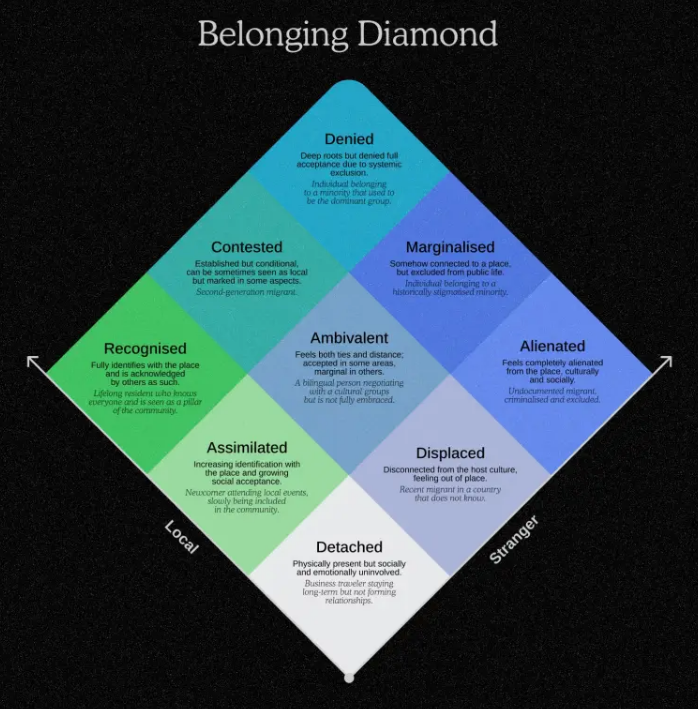
Rethinking Data Through Gender Diamonds and Belonging Spectra
As our digital tools evolve, so must the methods we use to collect and visualize identity data. Two recent contributions in Nightingale, Querying the Quantification of the Queer and Datafying Mixed Social Identities: Nonbinarity as the Complementary of Intersectionality highlight how current systems fall short of capturing the fluid, layered realities of gender and other social identities. Both works push us beyond rigid binaries to imagine new, more inclusive data structures rooted in feminist and queer theory.
Why Gender Isn’t Just a Checkbox
Traditionally, surveys and forms ask for gender using fixed categories, typically “male,” “female,” and sometimes “other.” In the US, of course, this is now federal law 😑
But these simplifications erase the complex and dynamic nature of real human experiences. In QQQ, design researcher and visual communicator Fe Simeoni challenges this approach by introducing two interactive visual tools: the Gender Diamond and the Gender Flower. Both tools provide a means to express gender identity as a blend of multiple dimensions, rather than a static label.

At the core of this work is a refusal to flatten gender into simple categories. Drawing on data feminism and queer theory, these charts utilize axes such as femininity, masculinity, and a third, queerer axis representing political or social disidentification. The result is a data structure that acknowledges people can have more than one gender identity, and that identity itself is subject to change, ambiguity, and nuance over time.
Simeoni collaborated with gender-nonconforming individuals and scholars in gender studies to develop their work. Importantly, they reflect how people see themselves, not how systems choose to see them.
Queerness as Potential, Not a Fixed Point
One of the most radical ideas in QQQ is that queerness cannot be fully pinned down in the present because it inherently points toward possibility. Inspired by José Esteban Muñoz’s theory of queerness as a “potentiality,” Simeoni treats identity as probabilistic. For example, a bigender person might express one identity 70% of the time and another 30%, and that ratio can change. Likewise, a pansexual person’s attractions may shift across gender combinations.
By applying visual models like “value-suppressing uncertainty palettes,” Simeoni captures not just where someone falls on a spectrum, but how strongly or uncertainly they identify with that point. This probabilistic approach offers a more honest and respectful way to reflect gender fluidity—and can help psychologists, researchers, and designers avoid the pitfalls of rigid classification.
Extending Nonbinarity Beyond Gender
The second article directly builds on this idea but extends it beyond the scope of gender. Their work, called the Belonging Diamond, illustrates how non-binary can be applied to various aspects of identity, including nationality, language, and cultural affiliation. Similar to the Gender Diamond, the Belonging Diamond employs two axes to map identity as a spectrum. For example, it can represent “Italianness” and “Germanness” in the context of South Tyrol, a culturally contested region in Italy. Rather than forcing individuals into rigid categories like “local” or “foreigner,” the Belonging Diamond permits people to express mixed or fluctuating experiences of identity, such as feeling both local and like a stranger or identifying with multiple cultural reference points. These tools are designed using social identity theory, which views identities as performative and shaped by social context, rather than as fixed realities.

From Intersectionality to Nonbinarity
The feminist concept of intersectionality, developed by scholars such as Kimberlé Crenshaw, examines how different social categories—such as race, gender, class, and disability—intersect to influence experiences of discrimination and privilege. Nonbinarity adds another layer by questioning the meaning of these identity categories. While intersectionality shows how categories intersect, nonbinarity challenges the categories themselves. For example, rather than simply labeling someone as both Black and female, a nonbinary perspective would explore what being “Black” and “female” truly means in different contexts and how these identities can blend or resist straightforward definitions. Combined, intersectionality and nonbinarity provide a more comprehensive understanding of the complexity of human experiences.
For example, instead of simply saying someone is both Black and female, a nonbinary lens would question what “Blackness” and “femaleness” even mean in different contexts, or how those identities shift, mix, or resist classification altogether.
Together, intersectionality and nonbinarity provide a more comprehensive toolkit for understanding—and visualizing—the complexity of human experience.
Why This Matters
These models are not just intellectual exercises—they have real-world implications. In public health, education, social research, and policy, binary data systems lead to exclusion, misrepresentation, and what some refer to as data violence: when individuals are rendered invisible or unintelligible by the categories used to describe them.
However, with more inclusive tools like the Gender Flower or Belonging Diamond, we can begin to create data structures that accurately reflect lived reality. These models respect uncertainty, prioritize self-description, and allow for identity to evolve over time.
There’s a risk, of course. Rich identity data, if misused, could expose queer individuals or minority populations to surveillance or harm. That’s why the authors emphasize the importance of intentionality and opt-in data collection, particularly when working with marginalized groups.
A Roadmap Toward Better Identity Data
As our societies become increasingly diverse and our technologies more advanced, we need to reconsider how we define and collect identity data. These visual tools, grounded in feminist design and queer theory, provide more than just improved charts; they present a vision of a more inclusive world where identities are not confined but allowed to flourish.



